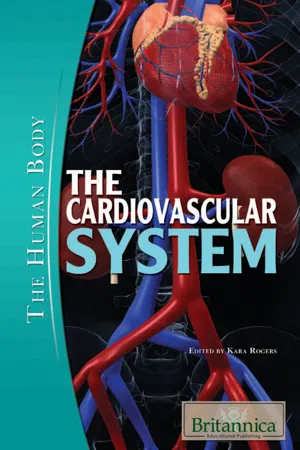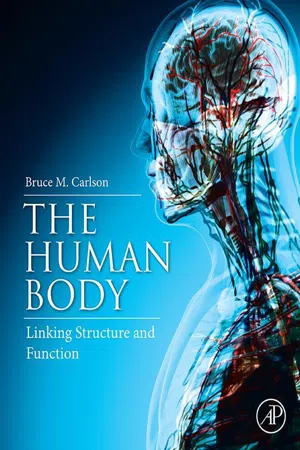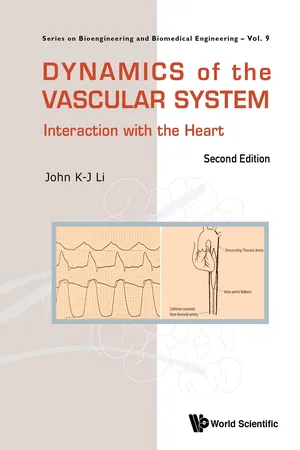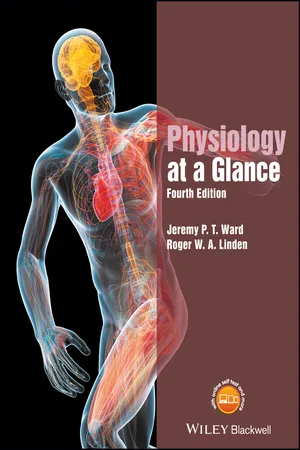Biological Sciences
Blood vessels
Blood vessels are a vital part of the circulatory system, responsible for transporting blood throughout the body. They include arteries, which carry oxygenated blood away from the heart; veins, which return deoxygenated blood back to the heart; and capillaries, where the exchange of nutrients and waste products occurs between the blood and tissues. These vessels play a crucial role in maintaining overall health and homeostasis.
Written by Perlego with AI-assistance
Related key terms
8 Key excerpts on "Blood vessels"
- eBook - ePub
Fundamentals of Applied Pathophysiology
An Essential Guide for Nursing and Healthcare Students
- Ian Peate, Ian Peate(Authors)
- 2021(Publication Date)
- Wiley-Blackwell(Publisher)
Figure 9.1 ). As the blood flows through the arterial system, it transports nutrients and other substances essential for cellular metabolism and for homeostatic regulation. The waste products of metabolism are transported by the venous system for removal by the kidneys, lungs and skin. This chapter discusses the structure and functions of the Blood vessels, factors affecting blood pressure, and vascular disorders and their related care.Overview of Blood vessels
In the human body, there are several kinds of Blood vessels. Arteries and arterioles are the vessels that convey blood away from the heart. They transport oxygen‐rich (oxygenated) blood, except the pulmonary arteries, which carry oxygen‐depleted blood. Veins and venules carry blood towards the heart and transport oxygen‐depleted (deoxygenated) blood, except the pulmonary veins, which carry oxygenated blood. Capillaries are the minute Blood vessels in between the arterial system and the venous system. They form a delicate network of vessels and are in close proximity to most parts of the body tissues. Blood vessels can dilate, constrict, pulsate and form a closed delivery system for the blood which begins and ends at the heart.Figure 9.1 Blood flow.Structure of the Blood vessels
Blood vessels, with the exception of the capillaries, are composed of three distinct layers (Marieb and Hoehn, 2019 ) and a central lumen through which blood flows (Figure 9.2 ). The outer layer is called the tunica externa, formally known as the tunica adventitia. It is largely composed of collagen fibres that protect and support the Blood vessels, and secure them to the surrounding tissues. The tunica externa is supplied with sympathetic nerve fibres and lymphatic vessels; the larger veins are also supplied with elastic fibres (Jenkins and Tortora, 2019 ).Figure 9.2 Structures of an artery and a vein.The tunica externa is involved in healing after injury, immunity and maintenance of vascular tone. A variety of special cell types are located in this structure to provide these effects. Macrophages, lymphocytes and dendritic cells are involved in immune function. Stem cells and fibroblasts are involved in healing after injury. Cells originating from the tunica externa have been shown to migrate to the tunica media and tunica intima during repair after vessel damage (McCance et al., 2018 - eBook - ePub
- Britannica Educational Publishing, Kara Rogers(Authors)
- 2010(Publication Date)
- Britannica Educational Publishing(Publisher)
CHAPTER 2THE BLOOD VESSELST he Blood vessels consist of a closed system of tubes that transport blood to all parts of the body and back to the heart. The major types of vessels include the arteries, veins, and capillaries. As in any biologic system, structure and function of the vessels are so closely related that one cannot be discussed without the other’s being taken into account.Because of the need for the early development of a transport system within the embryo, the organs of the vascular system are among the first to appear and to assume their functional role. In fact, this system is established in its basic form by the fourth week of embryonic life. At approximately the 18th day of gestation, cells begin to group together between the outer skin (ectoderm) and the inner skin (endoderm) of the embryo. These cells soon become rearranged so that the more peripheral ones join to form a continuous flattened sheet enclosing more centrally placed cells. These cells remain suspended in a fluid medium as primitive blood cells. The tubes then expand and unite to form a network; the primitive Blood vessels thus appear.In the human body, there exist discrete systems of vessels that perform very specific functions while also contributing to the overall circulation of blood. The portal system, for example, consists of a network of vessels and is specially designed to transport blood from the abdomen to the liver, where nutrients, wastes, and other substances that have been absorbed from the gastrointestinal tract are metabolized. The processed blood then leaves the liver and travels to the heart. Two other readily distinguished systems are the pulmonary circulation, which is a closed network of vessels that supplies blood only to the heart and lungs, and the systemic circulation, which supplies blood to tissues throughout the body. - eBook - ePub
- Robert G. Carroll(Author)
- 2006(Publication Date)
- Mosby(Publisher)
8Vascular System
CONTENTSBLOOD VESSEL HISTOLOGY VASCULAR SEGMENTSArteries and Arterioles Microcirculation Vasculature Venules and Veins LymphaticsHEMODYNAMICSArterial Blood PressureMICROCIRCULATIONTranscapillary Exchange Interstitial Fluid Pressure and Volume Local Control of Blood FlowNEURAL AND HORMONAL REGULATION OF VASCULATUREVascular Smooth Muscle Tone Central Nervous System Integration Control of Vascular Smooth MuscleCIRCULATION IN SPECIFIC VASCULAR BEDS TOP 5 TAKE-HOME POINTSThe cardiovascular system transports nutrients to tissues and removes metabolic waste, including heat. The exchange of nutrients and wastes between the blood and the tissues occurs in the small Blood vessels, primarily by diffusion. Metabolic wastes are eliminated from the body by the kidneys, lungs, skin, and gastrointestinal tract. Blood flow helps maintain a relatively constant internal environment throughout the body.Peripheral blood vessel structure varies throughout the circulation. Vascular smooth muscle is arranged helically or circularly around vessels, so that contraction reduces vessel diameter. Vascular smooth muscle contracts by actin-myosin cross-bridging, and intracellular Ca++ regulates the strength of contraction. Calcium dynamics is complex because Ca++ can enter through voltage-gated channels, can enter through receptor-operated channels, or can be released from the sarcoplasmic reticulum. Most vascular smooth muscle is innervated by sympathetic nerves, and basal sympathetic nerve activity causes a resting level of contraction (vasomotor tone).Tissue blood flow is controlled by local metabolic needs—acutely, by adjusting vascular resistance, and chronically, by angiogenesis to change capillary density. Tissues with high metabolic rates have high blood flow and high capillary density. Tissues with low metabolic rates have low blood flow and low capillary density. An increase in metabolic rate leads to an increase in tissue blood flow, such as in skeletal muscle during exercise. This mechanism depends on arterial pressure being sufficiently high. - eBook - ePub
- Ruth Hull(Author)
- 2021(Publication Date)
- Lotus Publishing(Publisher)
9 The Cardiovascular System IntroductionEvery cell in the body needs oxygen to survive and there is only one way they can get it – through the blood. In turn, this life-giving substance depends on a small, fist-sized organ to pump it around the body – the heart. This vital organ is very simple in its structure, yet it pumps blood through approximately 100,000 km of vessels to over 60 billion cells. Together, the blood, the heart and its vessels form the cardiovascular system, and in this chapter you will discover the important role this system plays in your body.Student objectives By the end of this chapter you will be able to:• Describe the functions of the cardiovascular system• Describe blood, its components and functions• Describe the heart and explain how it functions• Explain what blood pressure is and how it is maintained• Describe the different types of Blood vessels• Explain the different types of circulation• Identify the primary Blood vessels of the body• Describe the common pathologies of the cardiovascular system.Did you know? Blood makes up 8% of your total body weight, and an average adult male has 5–6 litres of blood in his body, while an average female has 4–5 litres.Blood Functions of bloodBlood is a liquid connective tissue that is slightly sticky and is heavier, thicker and more viscous than water. It is a vital substance in the body that functions in transportation, regulation and protection. - eBook - ePub
The Human Body
Linking Structure and Function
- Bruce M. Carlson(Author)
- 2018(Publication Date)
- Academic Press(Publisher)
At all levels in the circulatory system, structure is closely attuned to functional requirements. These structural adaptations range from the gross structure of the heart and the cardiac valves to the configuration of the cells lining some of the specialized capillary beds. Problems can arise when age or pathology interfere with the delicate balance between structure and function.Blood
Blood is the medium through which the circulatory system operates. The adult human circulation contains approximately 5 L of blood, but the amount of circulating blood is in some form of equilibrium with reserves of noncirculating blood in the liver and spleen and with interstitial fluid in the tissues.Blood consists of two main parts—plasma and cells. Each of these is itself a complex mixture. All of the components within the blood—both cellular and molecular —have normal ranges of abundance, but the relative and absolute amounts of specific components in the blood also vary according to the needs of the body at the time. For example, numbers of certain types of white blood cells can rise precipitously during infective processes, and the number of red blood cells increases significantly in people who live at high altitudes.Blood Cells
Blood cells , or their equivalents, have a long evolutionary history. Even the most primitive multicellular animals, such as sponges, contain cells, called amebocytes, which move about and perform phagocytic functions. These cells are not confined to vessels, but rather move about in spaces between tissue layers. Higher up the evolutionary scale, starting with worms, different types of blood cells appear. Some are still phagocytic, but others are involved in cell-mediated immune responses or in clotting reactions to injury.Red blood cells, which carry oxygen, are not found in invertebrates. Some smaller species are able to supply oxygen to their tissues directly through small open channels to the outside. Larger species or more complex invertebrates often possess a poorly developed vascular system, but they distribute oxygen to their tissues by means of large oxygen-carrying molecules, which are directly dissolved in their tissue fluids. One such molecule is hemocyanin - eBook - ePub
Dynamics of the Vascular System
Interaction with the Heart
- John K-J Li(Author)
- 2018(Publication Date)
- WSPC(Publisher)
Because of this, veins are stiffer than arteries. However, the low operating pressure and collapsibility allows veins to increase their volume by several times under a small increase of distending pressure. There are bicuspid valves in veins. These valves permit unidirectional flow, thus preventing retrograde blood flow to tissues due to high hydrostatic pressures. These valves are notably present in the muscular lower limbs. 2.1.5 The Microvasculature As stated previously, the function of the cardiovascular system is to provide a homeostatic environment for the cells of the organism. The exchange of the essential nutrients and gaseous materials occurs in the microcirculation at the level of the capillaries. These microvessels are of extreme importance for the maintenance of a balanced constant cellular environment. Capillaries and venules are known as exchange vessels where the interchange between the contents in these walls and the interstitial space occur across their walls. The microcirculation can be described in terms of a network such as that shown in Fig. 7.1.1. It consists of an arteriole and its major branches, the metarterioles. The metarterioles lead to the true capillaries via a precapillary sphincter. The capillaries gather to form small venules, which in turn become the collecting venules. There can be vessels going directly from the metarterioles to the venules without supplying capillary beds. These vessels form arteriovenous (A-V) shunts and are called arteriovenous capillaries. The capillary and venule have very thin walls. The capillary, as mentioned before, lacks smooth muscle and only has a layer of endothelium. The smooth muscle and elastic tissue are present in greater amounts in vessels having vasoactive capabilities, such as arterioles. This is also the site of greatest drop in mean blood pressure - Neil Herring, David J. Paterson(Authors)
- 2018(Publication Date)
- CRC Press(Publisher)
1 Overview of the cardiovascular system1.1 Diffusion: its Virtues and Limitations1.2 Functions of the Cardiovascular System1.3 The Circulation of Blood1.4 Cardiac Output and Its Distribution1.5 Introducing ‘Hydraulics’: Flow, Pressure and Resistance1.6 Blood Vessel Structure1.7 Functional Classes of Vessel1.8 The Plumbing of the Circulation1.9 Control Systems• Summary • Further ReadingLEARNING OBJECTIVES
After reading this chapter you should be able to:- outline the distance limitation of diffusive transport and the roles of diffusion versus convection in oxygen transport (1.1);
- list the differences between the pulmonary and systemic circulations (1.3);
- sketch out how blood pressure (BP), velocity and total cross-sectional area change from the aorta to the microcirculation and to the vena cava (Figure 1.10 );
- write down the basic law of flow (1.5) and apply it to work out the main source of vascular resistance; sketch the structure of the blood vessel wall (Figure 1.11 ) and state the roles of the endothelium, elastin, collagen and vascular smooth muscle;
- name five main functional categories of blood vessel and state their roles (1.7);
- define a ‘portal circulation’ and explain its functional value (1.8).
The heart and Blood vessels evolved to transport O2 , nutrients, waste products and heat around the body rapidly. This is crucial for tissue viability, so the cardiovascular system (C VS) develops at an early stage in the embryo. However, very tiny organisms lack a circulatory system - their O2- eBook - ePub
- Jeremy P. T. Ward, Roger W. A. Linden(Authors)
- 2017(Publication Date)
- Wiley-Blackwell(Publisher)
Part 3 The cardiovascular systemChapters- 19: Introduction to the cardiovascular system
- 20: The heart
- 21: The cardiac cycle
- 22: Initiation of the heart beat and excitation–contraction coupling
- 23: Control of cardiac output and Starling’s law of the heart
- 24: Blood vessels
- 25: Control of blood pressure and blood volume
- 26: The microcirculation, filtration and lymphatics
- 27: Local control of blood flow and specific circulations
Passage contains an image
19 Introduction to the cardiovascular system
The cardiovascular system comprises the heart and Blood vessels, and contains ∼5.5 L of blood in a 70 kg man. Its main functions are to distribute O2 and nutrients to tissues, transfer metabolites and CO2 to excretory organs and the lungs, and transport hormones and components of the immune system. It is also important for thermoregulation (Chapter 13). The cardiovascular system is arranged mostly in parallel, i.e. each tissue derives blood directly from the aorta (Figure 19.1). This allows all tissues to receive fully oxygenated blood, and flow can be controlled independently in each tissue against a constant pressure head by altering the resistance of small arteries (i.e. arteriolar constriction or dilatation). The right heart, lungs and left heart are arranged in series. Portal systems are also arranged in series, where blood is used to transport materials directly from one tissue to another, such as the hepatic portal system between digestive organs and the liver. The function of the cardiovascular system is modulated by the autonomic nervous system (Chapter 8).Blood vessels
The vascular system consists of arteries and arterioles that take blood from the heart to the tissues, thin-walled capillaries that allow the diffusion of gases and metabolites, and venules and veins that return blood to the heart. The blood pressure, vessel diameter and wall thickness vary throughout the circulation (Figures 19.2 and 19.3). Varying amounts of smooth muscle are contained within the vessel walls, allowing them to constrict and alter their resistance to flow (Chapters 12 and 24). Capillaries contain no smooth muscle. The inner surface of all Blood vessels is lined with a thin monolayer of endothelial cells, important for vascular function (Chapter 24). Large arteries are elastic and partially damp out oscillations in pressure produced by the pumping of the heart; stiff arteries (age, atherosclerosis) result in larger oscillations. Small arteries contain relatively more muscle and are responsible for controlling tissue blood flow. Veins have a larger diameter than equivalent arteries, and provide less resistance. They have thin, distensible walls and contain ∼70% of the total blood volume (Figure 19.3). Large veins are known as capacitance vessels and act as a blood volume reservoir; when required, they can constrict and increase the effective blood volume (Chapter 24). Large veins in the limbs contain one-way valves, so that when muscle activity (e.g. walking) intermittently compresses these veins they act as a pump, and assist the return of blood to the heart (the muscle pump
Learn about this page
Index pages curate the most relevant extracts from our library of academic textbooks. They’ve been created using an in-house natural language model (NLM), each adding context and meaning to key research topics.







